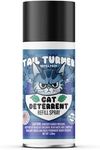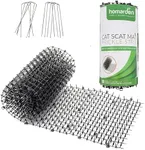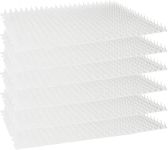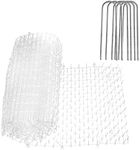Buying Guide for the Best Cat Deterrents
Choosing the right cat deterrent can help you protect your garden, furniture, or any other area from unwanted feline visitors. The key to selecting the best cat deterrent is understanding the different types available and how they work. By considering your specific needs and the environment where you plan to use the deterrent, you can make an informed decision that effectively keeps cats at bay without causing them harm.Type of DeterrentCat deterrents come in various types, including ultrasonic devices, motion-activated sprinklers, scent-based repellents, and physical barriers. The type of deterrent is important because it determines how the product will interact with the cats and the environment. Ultrasonic devices emit high-frequency sounds that are unpleasant to cats but inaudible to humans. Motion-activated sprinklers spray water when they detect movement, startling the cat. Scent-based repellents use smells that cats dislike, such as citrus or certain herbs. Physical barriers, like netting or spikes, prevent cats from accessing specific areas. To choose the right type, consider the area you need to protect and the behavior of the cats you are dealing with. For example, if you want to keep cats out of your garden, a motion-activated sprinkler might be effective, while an ultrasonic device could be better for indoor use.
Coverage AreaThe coverage area of a cat deterrent refers to the amount of space it can effectively protect. This is important because it ensures that the entire area you want to keep cat-free is covered. Coverage areas can range from small, targeted spots to large, open spaces. Small coverage areas are suitable for protecting specific items like furniture or flower beds, while larger coverage areas are ideal for yards or gardens. To determine the right coverage area for you, measure the space you need to protect and choose a deterrent that can cover that size. If you have a large area, you may need multiple devices or a deterrent with a wide range.
Power SourceCat deterrents can be powered by batteries, solar energy, or electricity. The power source is important because it affects the convenience and placement of the device. Battery-powered deterrents are portable and can be placed anywhere, but they require regular battery changes. Solar-powered deterrents are eco-friendly and low-maintenance, as they recharge during the day, but they need to be placed in sunny areas. Electric deterrents are reliable and consistent, but they need to be near a power outlet. To choose the right power source, consider where you will place the deterrent and how much maintenance you are willing to do. For example, if you need a deterrent for a remote area, a battery-powered or solar-powered option might be best.
Sensitivity and Range SettingsSensitivity and range settings allow you to adjust how the deterrent responds to movement or presence. This is important because it helps you customize the device to your specific needs and environment. High sensitivity settings can detect smaller movements, which is useful for areas with a lot of activity, while lower sensitivity settings are better for reducing false alarms. Range settings determine how far the deterrent can detect and respond to cats. To choose the right settings, consider the typical behavior of the cats and the layout of the area. For example, if you have a large, open yard, you might need a deterrent with a wide range and high sensitivity.
Durability and Weather ResistanceDurability and weather resistance refer to how well the deterrent can withstand outdoor conditions. This is important because it ensures the device will last and remain effective over time. Durable materials and weather-resistant features, such as waterproofing, protect the deterrent from rain, wind, and sun damage. To choose a durable and weather-resistant deterrent, consider the climate and conditions in your area. For example, if you live in a region with heavy rainfall, look for a deterrent with high waterproof ratings.


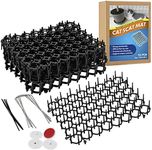
![Berkland [4 Pack] Refill for PetSaf](https://images-proxy.bestreviews.guide/_YayCtSRbIBxgjkGmYdkv0oUVvk=/0x150/https://m.media-amazon.com/images/I/51nR3rWNXrL._AC_CX679_.jpg)

